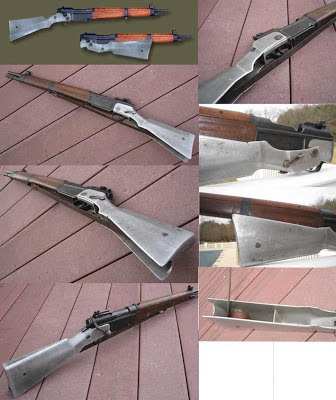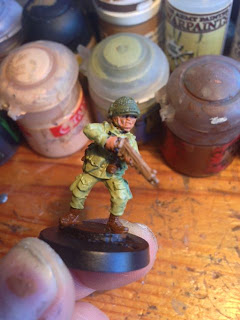Grenades
There are 2 main types of French grenades, the Offensive Grenade model 1937 and the Defensive Grenade 1937. Both have an effective range of 30 m and external colors identifying their type of explosive. They are either all yellow or with the bottom part in red.
The Offensive Grenade model 1937 (OF37) is not a fragmentation grenade but use the blast to incapacitate the enemy in a 10 m radius of the point of impact.
The Defensive Grenade model 1937 (DF37) is a fragmentation grenade, lethal in a 5 m radius, and very dangerous up to 50 m.
The WW2 US Mk2 defensive grenade is also very common. It is a fragmentation grenade, color olive drab, and with a lethality similar to the French DF37.
Friday, 24 May 2013
Wednesday, 22 May 2013
More splendid painting by Andy
Some more pics of our figures painted by the talented Andy
We hope to have soon professional quality photos of some of them
We hope to have soon professional quality photos of some of them
and finally, pending the new heads by Paul Hicks, an unofficial conversion nicely made ;-)
Most famous paratroopers units - Part 1
6e Bataillon de Parachutistes Coloniaux (6e BPC)
The famous "Bigeard bataillon", from the name of his illustrious leader, the "Chef de Bataillon" (Commandant) Marcel Bigeard (1916-2010).
The battalion arrived in Indochina on 25/07/1952. From August 12 to October 7, it operate in the Vinh-Yen and Phuc-Yen sectors in the proximity of Hanoï. On October 16 it is airdropped in Thaï country in the Tu-Lé region. After some heavy fighting and a withdrawal toward Na-San, it is recovered on October 26. On December 27, it is again airdropped in the Thaï country, this time in the Ban-Som region and make a number of raids from Na-San.
From April 30 to May 23 1953, the battalion is engaged in the defense of Luang-Prabang, the capital of Laos. From July 17 to 20, it leads, with 8e BPC, the famous Operation "Hirondelle" (Swallow), a daring raid on Lang-Son, in the heart of Vietminh territory. Many caches of weapons and equipment are seized and destroyed, followed by an epic retreat by foot through the jungle to the French lines.
From August 28 to October 21, the 6e BPC conducted local operations in the sectors of Nam-Dinh, Phu-Ly and Phat-Diem.
On November 20 1953, in Operation "Castor" (Beaver), the battalion is airdropped on Dien Bien Phu, seizing, in short but violent fight, the zone of the future entrenched camp.
Back in Hanoï, the unit is airlifted on Seno on December 30, fighting in the region until February 19 1954.
On March 16 1954, the 6e BPC is again airdropped on Dien Bien Phu, in the middle of a worsening situation. There, it will fight to the end, disappearing in violent and chaotic combats on Eliane 10 in the night of May 6-7. The survivors will go in a terrible detention from which few will come back.
The losses (KIA & MIA) of the battalion are: 9 Officers, 41 NCO, 288 men (126 of them indigenous).
Motto : " Croire et Oser" (Believe and Dare)
The famous "Bigeard bataillon", from the name of his illustrious leader, the "Chef de Bataillon" (Commandant) Marcel Bigeard (1916-2010).
 |
| Bigeard at Dien Bien Phu |
The battalion arrived in Indochina on 25/07/1952. From August 12 to October 7, it operate in the Vinh-Yen and Phuc-Yen sectors in the proximity of Hanoï. On October 16 it is airdropped in Thaï country in the Tu-Lé region. After some heavy fighting and a withdrawal toward Na-San, it is recovered on October 26. On December 27, it is again airdropped in the Thaï country, this time in the Ban-Som region and make a number of raids from Na-San.
From April 30 to May 23 1953, the battalion is engaged in the defense of Luang-Prabang, the capital of Laos. From July 17 to 20, it leads, with 8e BPC, the famous Operation "Hirondelle" (Swallow), a daring raid on Lang-Son, in the heart of Vietminh territory. Many caches of weapons and equipment are seized and destroyed, followed by an epic retreat by foot through the jungle to the French lines.
 |
| On the planes to Dien Bien Phu |
From August 28 to October 21, the 6e BPC conducted local operations in the sectors of Nam-Dinh, Phu-Ly and Phat-Diem.
On November 20 1953, in Operation "Castor" (Beaver), the battalion is airdropped on Dien Bien Phu, seizing, in short but violent fight, the zone of the future entrenched camp.
 |
| Castor begin. On the Ground at Dien Bien Phu |
Back in Hanoï, the unit is airlifted on Seno on December 30, fighting in the region until February 19 1954.
On March 16 1954, the 6e BPC is again airdropped on Dien Bien Phu, in the middle of a worsening situation. There, it will fight to the end, disappearing in violent and chaotic combats on Eliane 10 in the night of May 6-7. The survivors will go in a terrible detention from which few will come back.
The losses (KIA & MIA) of the battalion are: 9 Officers, 41 NCO, 288 men (126 of them indigenous).
Monday, 20 May 2013
The main individuals weapons of the French paras. Part 3
The M1 Carbine
The M1 carbine is a lightweight, easy to use semi-automatic carbine that became standard firearm for the U.S. military during WW2. With a total of 6.5 million M1 carbines of various models manufactured, it is the most produced American small arm of WW2.
The carbine was chambered for a new cartridge, the .30 Carbine, a smaller and lighter .30 (7.62mm) caliber round. The M1 carbine is accurate at short ranges, its effective combat range being around
180 m.
The M1 carbine, both in its standard and folding stock versions, was extensively used by the French paratroopers both in Indochina and Algeria albeit mainly by Officers and NCO.
The M1 carbine is a lightweight, easy to use semi-automatic carbine that became standard firearm for the U.S. military during WW2. With a total of 6.5 million M1 carbines of various models manufactured, it is the most produced American small arm of WW2.
The carbine was chambered for a new cartridge, the .30 Carbine, a smaller and lighter .30 (7.62mm) caliber round. The M1 carbine is accurate at short ranges, its effective combat range being around
180 m.
The M1 carbine, both in its standard and folding stock versions, was extensively used by the French paratroopers both in Indochina and Algeria albeit mainly by Officers and NCO.
Friday, 17 May 2013
The main individuals weapons of the French paras. Part 2
The Mat-49 smg
Developed by the French arms factory Manufacture Nationale d'Armes de Tulle (MAT) and first produced in 1949, the MAT-49 submachine gun saw widespread combat use during the First Indochina War and the Algerian War, notably with the paratroopers.
The MAT-49 had a retractable wire stock, which when extended gave the weapon a length of 720mm, and the magazine well and magazine could be folded forward parallel to the barrel for parachute jump.
It fires a 9mm cartridge, using a single-column 20-round or 32-round magazine.
Developed by the French arms factory Manufacture Nationale d'Armes de Tulle (MAT) and first produced in 1949, the MAT-49 submachine gun saw widespread combat use during the First Indochina War and the Algerian War, notably with the paratroopers.
The MAT-49 had a retractable wire stock, which when extended gave the weapon a length of 720mm, and the magazine well and magazine could be folded forward parallel to the barrel for parachute jump.
It fires a 9mm cartridge, using a single-column 20-round or 32-round magazine.
Thursday, 16 May 2013
The main individuals weapons of the French paras. Part 1
MAS-36/CR39 Paratrooper Rifle
Developed in 1939 from the new French standard infantry rifle the MAS-36, the MAS-36/CR39 was a shortened, lightened and streamlined version of the latter. The new aluminium folding stock swings up against the rifle’s receiver with a recess allowing it to hug the rifles contours and possess an auto-winding leather strap that is wound inside the stock once the rifle is folded. With the stock folded the CR39 was just 62cm long while a full length MAS-36 was over 100cm long.
As the MAS-36 was already a very short weapon, by shortening it further the effect of recoil was increased. Additionally the single bolt hinge was susceptible to fatigue and, with time, can be very difficult to use.
Not used during WW2, the CR39 did however see extensive service during France’s post war colonial conflicts in both Indochina War and Algeria.
French paratroopers shoes
Some of the main shoes used by the paratroopers. French or American jump boots were generaly used to jump, but on land they were frequently exchanged for the more comfortable laced boots or bush shoes.
Wednesday, 15 May 2013
Tuesday, 14 May 2013
TO&E for a 1953-1954 French Para Company
These information are entirely indicative and are likely to be subject to many variations following the relevant units and operations.
Monday, 6 May 2013
The American M-1 helmet
Following WW2, there are no French build combat and jump helmet available. With a very large utilization in the French army, the American M-1 helmet is representative of French paras silhouette in Indochina.
A number of versions with different modifications, essentially in regard of the strapping specific to jump helmets, will be in coexistence during the conflict.
Here are some view of the way to wear them
The use of a heavy helmet in Indochina is widespread in combat situation, more so in siege like Dien Bien Phu. The use of more lightweigth headgears (bush hat, beret, cap) is generaly reserved for less tense situations and for patrol.
A number of versions with different modifications, essentially in regard of the strapping specific to jump helmets, will be in coexistence during the conflict.
Here are some view of the way to wear them
The use of a heavy helmet in Indochina is widespread in combat situation, more so in siege like Dien Bien Phu. The use of more lightweigth headgears (bush hat, beret, cap) is generaly reserved for less tense situations and for patrol.
Photo tutorial to painting TAP47-52 uniform
Thanks to the talented Andy, we can give you here a small but very effective tutorial on how to paint the TAP57-52 paratroopers uniform.
Andy has chosen acrylic paints from the Game Workshop range.
Embarrassingly easy. But I like it this way....!
Cheers
Andy
Andy has chosen acrylic paints from the Game Workshop range.
First step
The base colours
Ratskin Flesh
Death World Forrest
Ogryn Camo
Mournfang Brown
2nd step
Tallarn Sand (webbing/ straps etc)
Leadbelcher
Leadbelcher
3rd step
Green camo stripes:
Loren Forrest
Loren Forrest
Brown camo stripes:
Gorthor Brown
Gorthor Brown
4th step
Brown wash with Agrax Earthshade(uniform/ skin/ helmet)
Black Wash with Nuln Oil (rifle/ metal parts/ boots)
5th step Highlights
Skin
Cadian Fleshtone
Cadian Fleshtone
Webbing/ equipment/ helmet
highlighted in their base colours again
Camo pattern highlighted with Ogryn Camo.
Careful, don't get carried away, it's camouflage after all ;-)
Final highlight skin with Kislev Flesh
Base done
Finished :-)
Embarrassingly easy. But I like it this way....!
Cheers
Andy
Subscribe to:
Posts (Atom)

















































